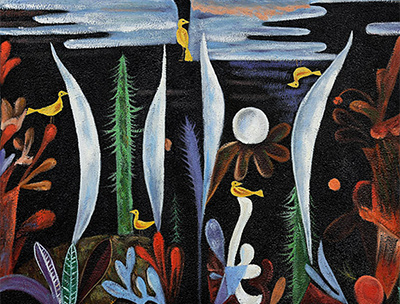In Landscape with Yellow Birds, the lines contribute to an overall pattern, using natural forms and geometric shapes.
Colour was everything to Paul Klee, and here, a variety of shades, shadows, light and darkness increase the feeling of movement in a dream-like setting, with his sharp sense of humour contributing a playful note.
Using similar techniques, he sought always to question the familiar, employing irony, and that can be picked up here. The picture's meaning, as always, was ambiguous and open to interpretation by both artist and viewer.
The painting continued to inspire, first as the title of a collection of poems by the Spanish metaphysical poet José Ángel Valente (1929–2000), and then in 1995 when the experimental film-maker Kostas Sfikas made a film about the artist, calling it “Paul Klee’s Prophetic Bird of Sorrows”.
After his Expressionist period, the Bauhaus years became more strongly associated with Elementarist Art, but two years before the production of Landscape with Yellow Birds, he exhibited in Paris as a Surrealist. Klee's 1920s output tended towards the abstract but never completely so.
Paul Klee (1879-1940) was a painter, draughtsman and printmaker, born in Switzerland but with German nationality. At one time he was part of the German Expressionist group Der Blaue Reiter (The Blue Four) with Wassily Kandinsky and others, and it was at their second exhibition in 1912 that he discoverd Cubism by way of artists like Picasso and Braque.
A trip to Paris led to his first trials in Abstract art, while a Tunisian visit awakened a lasting passion for colour. Although it's hard to place him in a particular movement, he inspired the New York School and many twentieth-century artists.
Working with oil paints, watercolours, pastels, ink and etching, he made use of common materials such as cardboard and muslin, as well as more conventional ones. Between the wars, Klee taught at the German Bauhaus school and the Dusseldorf Art Academy, but Nazi persecution forced his return to Switzerland with his wife in 1933.
While in Germany, he produced important works like 1922's Affected Place, and Landscape with Yellow Birds the following year. As a musician, he saw a connection between the two disciplines, and the viewer will notice a rhythmic flow running through this picture.




